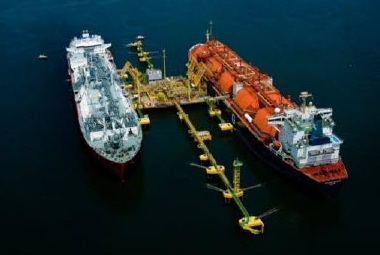In Part 1 (The Race To Supply LNG), I explained how the Japanese will most likely solve its power shortage, now that there are NO nuclear plants running.
One of the biggest answers is LNG—Liquid Natural Gas—and an emerging LNG technology that is growing around the world… and could be a fast answer to Japan’s dire need to quickly replace their nuclear power.
It’s called FSRU—which stands for Floating Storage and Regasification Unit. It’s a floating LNG import terminal — at less than half the cost of an onshore facility. The benefits to Japan now—which is in a proverbial “space race” to meet its electricity needs, are that they can be ordered, made and delivered in 2-3 years, vs. 5-7 years for an onshore import terminal.
FSRUs and onshore LNG import terminals take LNG and regasify it—taking it from the liquid form, where it is reduced 600:1 in volume and expanding it back into a gaseous form where it’s usable to make electricity in your home, and for other uses.
Both facilities need a berth for the LNG ship, storage tanks and pipelines. But the traditional, land-based terminals can cost upwards of $700 million for a facility with a peak capacity of about 7.75 million tons per year (around 1 bcf/d). Terminals operate at roughly half of their peak capacity.
These onshore facilities can take 5-7 years to be planned, constructed and brought online, which means they are not ideal for Japan’s current situation.
 As I said, FSRUs are custom-built vessels — similar to the LNG carriers but with the ability to turn LNG into its gaseous form.
As I said, FSRUs are custom-built vessels — similar to the LNG carriers but with the ability to turn LNG into its gaseous form.
FSRUs not only get to market faster, but cheaper: A newly built FSRU costs close to $260 million, according to Unit Economics (and they do the best research in this sector, by a nautical mile).
One company has even started converting old LNG carriers into FSRUs, for which Unit Economics says the cost is more like $160 million—and can be ready in just 14-16 months.
Another advantage is that they can be moved to wherever demand is highest for the regasification of LNG.
However, FSRUs have one big drawback—less capacity. Most have a peak capacity of around 4 million tons annually (about 500 million cubic feet per day), though some of the new ones are getting closer to 1 bcf/d.
A potential drawback for the Japanese could be that this technology is so new, there are only 10 working in the world right now, with another seven being tendered.
So while they are proven, they cannot yet be called mainstream. But there are already several large shipyards able to build them, and competition for bids is intense; i.e., there is a healthy supplier’s market.
Still, it should be noted that even if Japan goes with FSRUs, it will still to take some time for them to start importing LNG. This time gap is another reason Drolet believes nuclear reactors will have to come back online to meet the country’s energy needs.
Publisher’s Note: LNG is one of the only bull markets right now in energy. The FSRU market is at the leading edge of this. They are new and exciting, and the growth rate right now is huge—likely 100% in the next two years. And the profits are rolling in fast for one of the leading companies in the space. This company has already built and sold 4 of them. The thing to keep in mind here — FSRUs are different than LNG carriers in that they are much longer contracts (10- to 20-year contracts), with great long-term cash flow—exactly the thing you can plan a dividend around.
And that’s what this company has done — having increased its dividend in each of the last four quarters. The total dividend increase during this time is 40%. How many companies are doing that in this market?
Analysts are calling for quarterly EBITDA (Earnings Before Interest, Taxes, Depreciation and Amortization) to DOUBLE in the next quarter—a 100% increase in just one quarter. Its utilization is 100%, and operating profit margins are an eye-popping 80%. That’s why they are one of the most profitable companies in the worldwide energy sector.
I bought the stock this week myself. And I encourage you to learn all you can about this play — Click here to keep reading…









